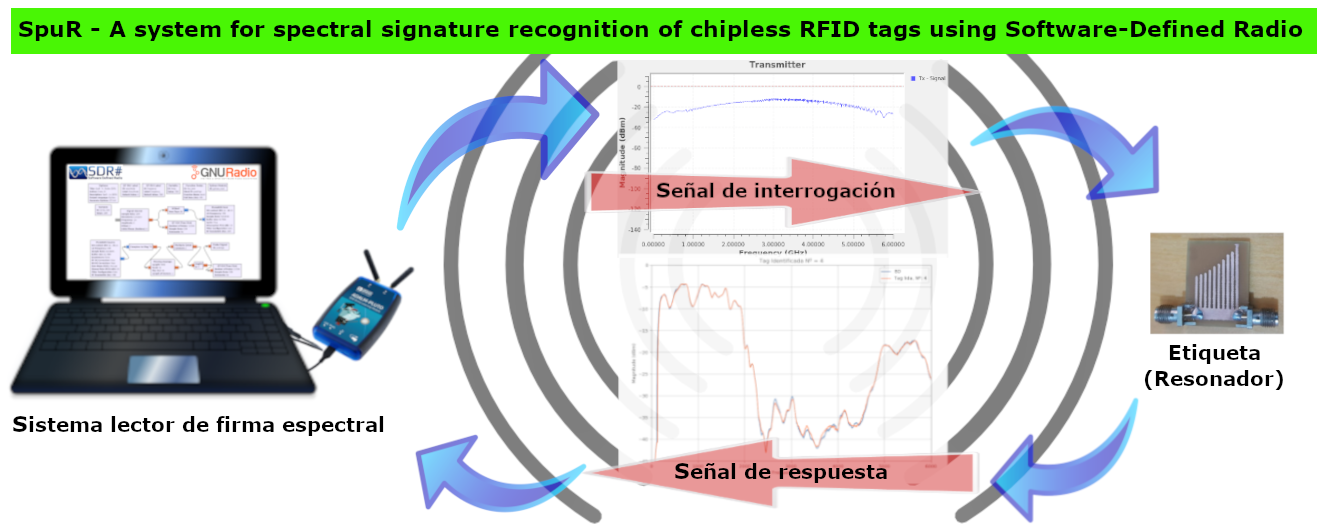SpuR - A system for spectral signature recognition of chipless RFID tags using Software-Defined Radio
Keywords:
Software-Defined Radio, SDR, Spectral Signature, Adalm Pluto, Chipless, RFID, SpuR, Radio definida por software, RDSAbstract
To solve problems related to Radio Frequency Identification, as well as to develop new technologies and applications with chipless RFID tags, this article describes the development of an innovative reader system based on Software-Defined Radios. Called SpuR, the system proposes a method of reading the spectral signature of RFID tags chipless, using general purpose hardware, reconfigurable by software, and operating in a wide frequency range without the need to change the reading equipment. This approach allows the accurate reading and identification of different types of chipless tags, using a classification procedure, by Euclidean distance, comparing them with a previously stored database.
Downloads
References
S. Preradovic and N. Karmakar, Multiresonator-Based Chipless RFID - Barcode of the Future. New York: Springer, 1a edição ed., 03 2012.
A. Subrahmannian and S. K. Behera, “Chipless rfid: A unique technology for mankind,” IEEE Journal of Radio Frequency Identification, vol. 6, pp. 151–163, 2022.
N. C. Karmakar, E. M. Amin, and J. K. Saha, Chipless RFID sensors. New Jersey: John Wiley & Sons, 1 ed., 2016.
J. Aliasgari, M. Forouzandeh, and N. Karmakar, “Chipless RFID Readers for Frequency-Coded Tags: Time-Domain or Frequency-Domain?,” IEEE Journal of Radio Frequency Identification, vol. 4, no. 2, pp. 146–158, 2020.
M. Garbati, E. Perret, and R. Siragusa, Chipless RFID Reader Design for Ultra-Wideband Technology: Design, Realization and Characterization. Elsevier, 2018.
C. Divarathne and N. Karmakar, “An advanced tag detection technique for chipless rfid systems,” in 2015 European Microwave Conference (EuMC), pp. 251–254, IEEE, 2015.
K. Yang, D. Forte, and M. M. Tehranipoor, “Ucr: An unclonable chipless rfid tag,” in 2016 IEEE International Symposium on Hardware Oriented Security and Trust (HOST), pp. 7–12, IEEE, 2016.
K. Yang, U. Botero, H. Shen, D. Forte, and M. Tehranipoor, “A split manufacturing approach for unclonable chipless rfids for pharmaceutical supply chain security,” in 2017 Asian Hardware Oriented Security and Trust Symposium (AsianHOST), pp. 61–66, IEEE, 2017.
J. Mitola, “The software radio architecture,” IEEE Communications Magazine, vol. 33, no. 5, pp. 26–38, 1995.
B. Riyanto, A. Z. Langi, A. Kurniawan, E. Marpanaji, A. Mahendra, and T. Liung, “Software architecture of software-defined radio (sdr),” ITB Research Center on ICT, 2006.
L. Liu and L. Chen, “Characteristic analysis of a chipless rfid sensor based on multi-parameter sensing and an intelligent detection method,” Sensors, vol. 22, no. 16, 2022.
G. Wan, M. Zhang, W. Li, and L. Chen, “A novel detection method based on maximum-likelihood estimation decoding of a 6-bit chipless radio frequency identification coded tag,” IEEE Transactions on Instrumentation and Measurement, vol. 70, pp. 1–11, 2020.
K. R. Brinker and R. Zoughi, “A review of chipless rfid measurement methods, response detection approaches, and decoding techniques,” IEEE Open Journal of Instrumentation and Measurement, vol. 1, pp. 1–31, 2022.
G. T. Santos-Souza, A. A. d. C. Alves, L. L. Bravo-Roger, and H. E. Hernández-Figueroa, “Numerical determination of frequency guard band resonances for chipless rfid tags,” in 2014 IEEE Brasil RFID, pp. 10–12, IEEE, 2014.
G. d. T. S. Souza, “Nova etiqueta chipless de rfid com comunicação redundante,” Master’s thesis, Faculdade de Tecnologia da Universidade Estadual de Campinas,UNICAMP, Limeira, 2015.
P. Prabavathi and S. S. Rani, “Design of frequency-signature based multiresonators using quarter wavelength open ended stub for chipless rfid tag,” in 2019 National Conference on Communications (NCC), pp. 1–6, 2019.
O. M. Haraz, “Design of 8-bit chipless printable rfid tags via spectral signature encoding for low-cost identifications,” Wireless Personal Communications, vol. 122, no. 3, pp. 2657–2665, 2022.
A. Vena, E. Perret, and S. Tedjini, “A fully printable chipless rfid tag with detuning correction technique,” IEEE Microwave and Wireless Components Letters, vol. 22, no. 4, pp. 209–211, 2012.
S. Sundaresan, C. Anjana, T. Zacharia, and R. Gandhiraj, “Real time implementation of fmcw radar for target detection using gnu radio and usrp,” in 2015 International Conference on Communications and Signal Processing (ICCSP), pp. 1530–1534, IEEE, 2015.
“ADALM-PLUTO Overview,” 2020. Acesso em: 03 junho 2022.
M. Sumi, R. Dinesh, C. Nijas, S. Mridula, and P. Mohanan, “High bit encoding chipless rfid tag using multiple e shaped microstrip resonators.” Progress In Electromagnetics Research B, vol. 61, pp. 185–196, 2014.
C. A. Lynch, A. O. Adeyeye, A. Eid, J. G. Hester, and M. M. Tentzeris, “5g/mm-wave next generation rfid systems for future iot applications,” in 2021 IEEE International Conference on RFID Technology and Applications (RFID-TA), pp. 77–80, IEEE, 2021.
A. Thomas11, J. Kurian, A. Thomas, and J. Kurian, “Interception amelioration of chipless rfid tags using deep learning techniques,” Journal of Science and Technology, vol. 8, no. 05, 2023.
N. Rather, R. B. V. B. Simorangkir, J. Buckley, B. O’Flynn, and S. Tedesco, “Evaluation of machine learning models for a chipless rfid sensor tag,” in 2023 17th European Conference on Antennas and Propagation (EuCAP), pp. 1–5, 2023.
E. L. Chuma and Y. Iano, “A movement detection system using continuous-wave doppler radar sensor and convolutional neural network to detect cough and other gestures,” IEEE Sensors Journal, vol. 21, no. 3, pp. 2921–2928, 2021.
M. Martín Merino, A. J. López Rivero, V. Alonso, M. Vallejo, and A. Ferreras, “A clustering algorithm based on an ensemble of dissimilarities: An application in the bioinformatics domain,” International Journal of Interactive Multimedia and Artificial Intelligence, vol. 7, no. 6, pp. 6–13, 2022.
A. Seal, E. Herrera Viedma, et al., “Performance and convergence analysis of modified c-means using jeffreys-divergence for clustering,” IJIMAI, vol. 7, no. 2, pp. 141–149, 2021.


